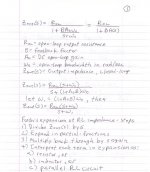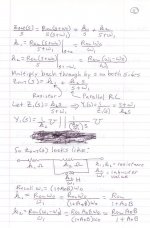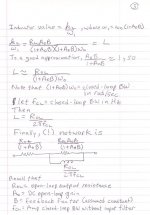A while back we were talking about output coils  . The subject of the output inductance of a feedback amp (without output inductor) came up. Namely, there's an inductive component of power amp output Z due to the feedback falling off as frequency increases.
. The subject of the output inductance of a feedback amp (without output inductor) came up. Namely, there's an inductive component of power amp output Z due to the feedback falling off as frequency increases.
I thought I'd try to find an equivalent RL circuit for the output impedance of such a feedback amp, based on a number of (really oversimplified) approximations and assumptions. The assumptions are:
1) Output impedance is purely resistive without feedback (yes I know this is not true in practice, but I'm looking for simple, first-order approximations here).
2) Open-loop gain is single-pole with DC value A0 and open-loop BW in rad/sec = w0 (= "omega naught")
3) Feedback factor = B is independent of frequency.
I did the derivation on paper using network synthesis techniques for RL circuits. I scanned these pages, as it's too difficult to do all the equations in the editor for the forum. Below is the first page of the derivation.
I thought I'd try to find an equivalent RL circuit for the output impedance of such a feedback amp, based on a number of (really oversimplified) approximations and assumptions. The assumptions are:
1) Output impedance is purely resistive without feedback (yes I know this is not true in practice, but I'm looking for simple, first-order approximations here).
2) Open-loop gain is single-pole with DC value A0 and open-loop BW in rad/sec = w0 (= "omega naught")
3) Feedback factor = B is independent of frequency.
I did the derivation on paper using network synthesis techniques for RL circuits. I scanned these pages, as it's too difficult to do all the equations in the editor for the forum. Below is the first page of the derivation.
Attachments
Here is the third (final) page of the derivation. You can observe that the value of the inductor of the network is:
1) Proportional to the open-loop output resistance
2) Inversely proportional to the closed-loop bandwidth (with the input filter removed)
The inductor value is on the order of tens of nH for a typical power amp. The formula for it is:
L = ROL / (2 * pi * fCL)
where ROL = open-loop output resistance
fCL = closed-loop bandwidth (with the input filter removed) = GBW / (nominal closed-loop gain)
Also note that the inductor is shunted by a resistor whose value is just slightly less than the open-loop output resistance (which could be quite small, especially in a design like the JC-1).
1) Proportional to the open-loop output resistance
2) Inversely proportional to the closed-loop bandwidth (with the input filter removed)
The inductor value is on the order of tens of nH for a typical power amp. The formula for it is:
L = ROL / (2 * pi * fCL)
where ROL = open-loop output resistance
fCL = closed-loop bandwidth (with the input filter removed) = GBW / (nominal closed-loop gain)
Also note that the inductor is shunted by a resistor whose value is just slightly less than the open-loop output resistance (which could be quite small, especially in a design like the JC-1).
Attachments
andy_c said:A while back we were talking about output coils. The subject of the output inductance of a feedback amp (without output inductor) came up. Namely, there's an inductive component of power amp output Z due to the feedback falling off as frequency increases.
.......
Nice contribution Andy!!
Do you mind if I check, put in pdf and upload? It should take some days though because of other work, but think it's worth, after cursory review.
Rodolfo
ingrast said:Do you mind if I check, put in pdf and upload? It should take some days though because of other work, but think it's worth, after cursory review.
Hi Rodolfo,
Thanks for your kind words.
I'd appreciate it very much if you'd check my work, thanks! I found some errors when I was reviewing the scans, and you can see that I crossed some stuff out because of that. It started as a bunch of scribble that I tried to clean up to make the ideas clear to other readers, and in that process, some errors could have crept in.
Thanks!
andy_c said:
...
I'd appreciate it very much if you'd check my work, thanks! ...
Will mail you a draft for proofreading as soon as ready.
Rodolfo
KBK said:The big trick..is if one 'gets it', at all. The idea is to open one's mind, not close it..or attempt to force another to conform to one's desire of how the universe works.
The open mind. I remember once discussing that concept. I think the discussion was referring to a form of Jazz where the musicians are incredibly tallented an play all the notes perfectly but it doesn't sound like music... Technically whose to fault them?
My intelligence is tickled when it sounds like music.
myhrrhleine said:
All it takes is a sweep gen. to hear the drivers go into and out of alignment (cancellation of sounds)
Agreed. But with music? Musical signals consist of various frequencies with various, and constantly varying, phase relationships. In music, there is a never ending sequence of destructive and constructive interferences.
I have seen a few tests that were either not conclusive, or ad-hoc, not controlled (the type of test with which you can 'prove' anything).
Jan Didden
john curl said:
Bob Crump worried when the fabricator, who had to do the helium-arc welding kept drinking beer after beer while putting it together. Therefore we decided to use aircraft grade alumium of one large piece and hog it it.
I suppose I would first have looked for another fabricator, one who doesn't drink at work. But that's just me.
Would you stop using cabs at all if you experience one single cab driver who has been drinking?
Alcoholism is the primary professional flaw of aluminium welders, the shaking hands lead to a natural welding movement i suppose 
While working at an aluminium molding company around 18, i learned arc welding from a guy who was drunk 24/7.
The trunk of his car was filled to the limit with beer every morning, great welder though untill he crossed the line and i put him in the hospital.

While working at an aluminium molding company around 18, i learned arc welding from a guy who was drunk 24/7.
The trunk of his car was filled to the limit with beer every morning, great welder though untill he crossed the line and i put him in the hospital.
janneman said:
.....
I have seen a few tests that were either not conclusive, or ad-hoc, not controlled (the type of test with which you can 'prove' anything).....
Jan,
Have you ever been tricked to the point of not being able to decide the fake from the real thing, for example a falling keyring or a shovel scratching the floor (there was a speaker manufacturer I don't recall that used this example) when actually done or played through speakers behind a curtain?
We are so woefully far from the goal of faithfull reproduction of a sound field that most subjective tests are prone to be inconclusive, much more so when our own cortical processing manages to provide intense delight even with heavily distorted renderings of our favorite gems.
Which is not to say we should not pursue accuracy anyway.
Rodolfo
Re: Re: Re: Re: Re: Re: Re: Re: Re: definition of 'rock solid'
 Well, Edmond, I wouldn’t call that degree of error “negligibly small” either, but that wasn't at all what I was referring to was it? I did not outline a method I use to determine the phase margin of my amplifier designs to +/-0.01 degrees or with such a capacitor across Rf (which is something I avoid for better RFI immunity).
Well, Edmond, I wouldn’t call that degree of error “negligibly small” either, but that wasn't at all what I was referring to was it? I did not outline a method I use to determine the phase margin of my amplifier designs to +/-0.01 degrees or with such a capacitor across Rf (which is something I avoid for better RFI immunity).
Thanks,
Glen
estuart said:
Hi Glen,
In addition to my reply #676, please have a look at the picture below, to make sure that we are not talking on cross purposes again.
Also, I have fiddled a bit with the "blameless" amp on my simulator. If R1 = 2k and C2 = 470pF, then the phase margin of the global feedback loop is 80 deg. If C2 = 0, then it becomes 75 deg. So there is a difference, admittedly, not that large, but I wouldn't call it "negligibly small". With your method, this difference would never be revealed.
Next, I made C4=2.7pF. Now, the phase margin is 92 deg. With your method we would still get 80 deg.
As said before, it is just as easy to do it the other (my) way, and (of course) it can be measured with the same equipment.
Cheers, Edmond.
Thanks,
Glen
ingrast said:
Jan,
Have you ever been tricked to the point of not being able to decide the fake from the real thing, for example a falling keyring or a shovel scratching the floor (there was a speaker manufacturer I don't recall that used this example) when actually done or played through speakers behind a curtain?
We are so woefully far from the goal of faithfull reproduction of a sound field that most subjective tests are prone to be inconclusive, much more so when our own cortical processing manages to provide intense delight even with heavily distorted renderings of our favorite gems.
Which is not to say we should not pursue accuracy anyway.
Rodolfo
Rodolfo,
You are preaching to the converted!
Jan
janneman said:
Rodolfo,
You are preaching to the converted!
Jan
Hi Jan, I was not really preaching, what I wanted to remark is the fact that given how far from actual faithfull reproduction we are, then subjective, listening or whatever one want to call it, results are bound to be inconclusive as it is in fact the case, witness the imposibility to agree even on what listening is all about.
Mix some cortical higher level processing and things get even worse.
Rodolfo
ingrast said:[snip]Mix some cortical higher level processing and things get even worse.
Rodolfo
Well, once you start to seriously study those issues, the danger is you might find it much more fascinating than audio (duck! duck!). So far I'm holding out.
Jan Didden
janneman said:
Agreed. But with music? Musical signals consist of various frequencies with various, and constantly varying, phase relationships. In music, there is a never ending sequence of destructive and constructive interferences.
I have seen a few tests that were either not conclusive, or ad-hoc, not controlled (the type of test with which you can 'prove' anything).
Jan Didden
But Jan,
That sweep will demonstrate that some frequencies the sounds from two drivers will cancel.
Sweeping only makes it readily obvious.
Don't we want to minimise defects in the reproduction chain?
It's worse than x-over notching in that it occurs at F 2F 3F...
It also can affect audible localisation, depending on driver layout.
Check for papers by Heyser, Richard.
JAES and audio magazine (where he did the speaker reviews)
PMA said:That is the real issue of some of you guys
Yes, in a way.
The morale for me is to keep within the boundaries of objective performance - i.e. accuracy - in design matters.
Then enjoy at will even if that means tweaking controls, only keep things sorted out.
Then again, if someone builds a bussiness out of mixing things just fine, product value equals consumer perceived value, not intrinsic technical merits. Perceived value may be obscenely bloated or in more subtle ways, there are scores of examples.
Rodolfo
- Status
- Not open for further replies.
- Home
- Amplifiers
- Solid State
- Audibility of output coils


